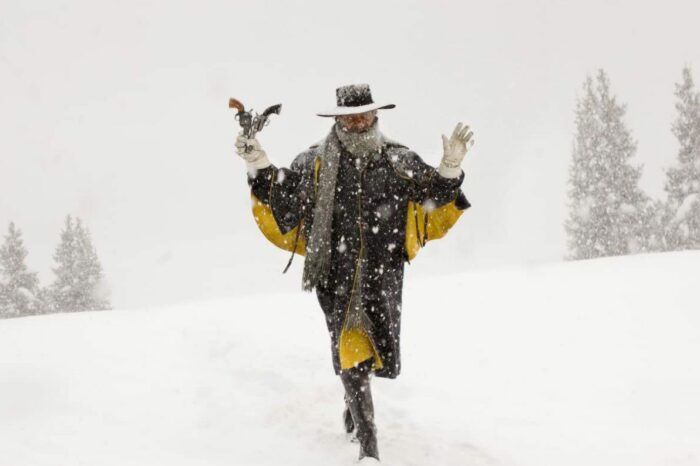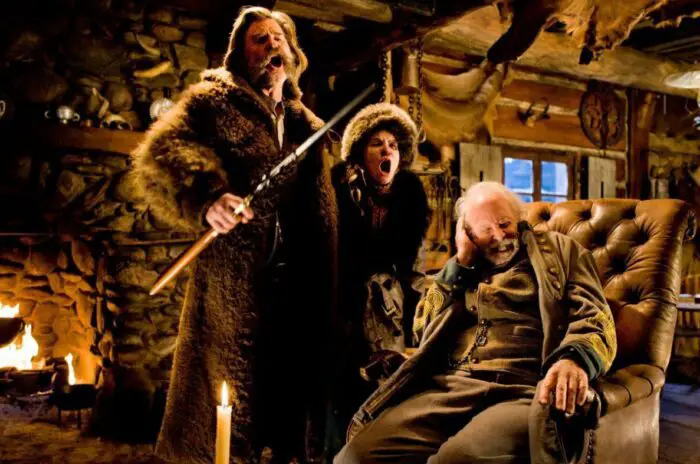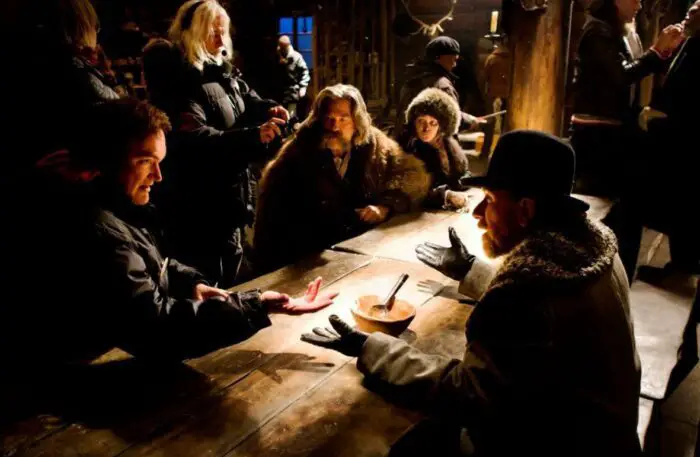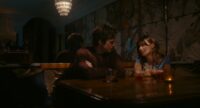Filmmaker Quentin Tarantino already holds the distinctive labels of talented, energetic, political, inspired, cool, violent, stylish, aficionado, artist, and satirist bestowed by many cinephiles, filmbros, and general fans alike. After beginning his career red-hot, he dug himself out of the misstep that was Death Proof to deliver two of his big box office successes in five years, namely his Oscar-winning Inglourious Basterds and the 2012 smash Django Unchained. Riding that high in 2015, the director was poised to expand his artistic dominance even more with the flashy 70mm release of The Hateful Eight.
At the time, Tarantino himself stated in GQ that it “could be my best movie.” To quote his Vincent Vega character from Pulp Fiction, “that’s a bold statement.” It’s one that missed. The Hateful Eight stood as a huge drop off that was virtually ignored by audiences. Its lavish failure amplified a long-festering divergent opinion about Quentin Tarantino’s work into one more label we can add to the colorful aforementioned list.
That label is: “acquired taste.” Even with those two big scores before The Hateful Eight and the partial return to form and glory after with Once Upon a Time… in Hollywood three years ago, the unique auteur’s excessive and aestheticized indulgences have caught up to him. For a time around The Hateful Eight in 2015, each of his subsequent films were getting more popular, but they weren’t getting better.
The Hateful Eight hammered that point home. Swelled to either a 168-minute general cut or a 187-minute “roadshow” opus complete with overture and intermission, Tarantino’s 2015 film didn’t know when to quit. It just goes and dies, literally and figuratively, when some delegation and self-control could have made all the difference.
The film opens in the director’s stylish signature fashion. The familiar font of his opening credits play behind the choice period-homage musical score composed by the then-87-year-old great Ennio Morricone. A stagecoach emerges in the background, riding through the hilly Wyoming snow, closer to a symbolic frozen wooden crucifix in our foreground. Pure Tarantino and so far so good. Shot selection has never been the man’s problem and frequent cinematographer collaborator Robert Richardson could make a pile of manure look majestic with or without a layer of snowy texture.

Aboard that wagon is the surly bounty hunter John Ruth (Kurt Russell). He has shackled himself to his latest $10,000 collar, the gang member Daisy Domergue (Jennifer Jason-Leigh). Ruth and his driver O.B. (James Parks) are on the road to Red Rock when they are stopped by another bounty hunter, Major Marquis Warren (Samuel L. Jackson), who was carrying three dead trophies of his own before his horse gave out.
After some initial paranoia, the two compromise to act as mutual protection for each other’s haul in exchange for Ruth giving Major Warren a ride the rest of the way. Soon, they gain another passenger in Chris Mannix (Walter Goggins), who claims to be the newly elected sheriff of Red Rock.
Let’s call all of that up to this point half of the necessary character introductions for yarn that is The Hateful Eight. The running time of this portion chimes in at two “chapters” and just over 34 minutes. That’s how long it takes just to arrive at the main setting. Folks, that’s a whole bunch of cud chewing and, again, only half of the introduction.

Carrying on, the blizzard gets worse and the stagecoach is forced to take shelter at Minne’s Haberdashery, a general store and watering hole. There, Ruth, Warren, Daisy, and Mannix find a lodge filled with an ensemble of questionable personas: Bob (Demian Bichir), is caretaking Minne’s while the owner is away, an old racist Confederate general by the name of Sanford Smithers (Bruce Dern) remains seated by the hearth while quiet farmhand Joe Gage (Michael Madsen) keeps to himself penning a written journal nearby. The welcoming talker of the crowd is Oswaldo Mobray (Tim Roth), the hangman of Red Rock.
All of them are stuck together until the blizzard dies down and the road melts ahead. Sure enough, stories are told, personalities clash, and beefs percolate among this combination of black hats and white hats, extending and completing what is the second half of the proper introductions.
The timestamp after this chapter is an hour later at 1:34. Yes, that’s a whole hour of preheating the oven, so to speak. Now, that’s not to say nothing happens. The barking confrontations and trigger-finger posturing all shed light on motivations and implied histories. They tease us of greater twists and importance to come, but, goodness gracious, a taut movie is done by this point.
There is no questioning Quentin Tarantino’s flair with the pen to write rich and boisterous characters operating in and out of catchy and lengthy conversations. He has always been cinema’s Chatty Cathy with the gift of gab. His dialogue-driven narratives burst with quotable panache and beguiling swagger. For a time, many loved that about him, until his verbal diarrhea went on and on and the movies got longer and longer chasing their own tails.
Assembling this kind of talent, including many repeat favorites, in The Hateful Eight, Tarantino brings the fullest enthusiasm out of this cast. Samuel L. Jackson is Tarantino’s most exemplary muse and leads with deadly, coiled glee. Tim Roth and Michael Madsen, two fellow Tarantino veterans, make it look easy. His newer collaborators, Kurt Russell (with a natural mustache for the ages), Jennifer Jason Leigh, and Walter Goggins, get their most plum roles in years.
The cast isn’t the problem and neither is the film’s look. Production designer Yohei Taneda decorated the hell out of the stage hull that became Minnie’s Haberdashery, with prop use and set decoration for the ages. Richardson soaked in the wide Colorado location exteriors and exposed every fleck of dirt and blood indoors to make the most out of the vibrant 70mm print. For aesthetic appeal, the use of actual film was a winning expense.
The culprits that knocks down The Hateful Eight are fluidity and pace. The first element of that error goes to Ennio Morricone’s score. Regurgitating too many retread motifs from decades past, his musical accompaniment comes and goes with long breaks and is used too infrequently to garner the proper effect. Seven year later, that gifted Oscar feels like a pity award for a dying old legend when the other nominees like Carter Burwell for Carol, Johan Johanssson for Sicario, and even John Williams for Star Wars: The Force Awakens elicited more juice for their respective movies.

The rest of the blame goes to the writer and director himself. Because of its exhausting length, The Hateful Eight takes its dear sweet time spelling out its six demarcated chapters and getting to both business and a point. The boredom is real and that shouldn’t happen in a good Quentin Tarantino movie.
The knee jerk response would be to say “Hire an editor!” Tarantino did. It was Fred Raskin who was coming off of the rollicking roller coaster that was Guardians of the Galaxy and the tightly chilling Bone Tomahawk before The Hateful Eight. But it’s like Tarantino didn’t let him work. Any sharpness or zip Raskin could have honed was either ignored or overstuffed to make room for more chit-chat.
If all of the long-winded build-up of tough talk was meant to lull us, it appeared for a while to work. That 94-minute mark started the fourth chapter with the tension finally snapping to set off violent Agatha Christie-style theatrics. Things get bloody, weird, and dismal in a hurry. Late or not, the true business seemed to finally arrive.
However, tight when The Hateful Eight should have been peaking to pay off its (and our) lengthy investment, Tarantino’s script tailspins with forced dramatic irony. He throws up an “earlier this morning” chapter card that triggers a huge rewind of deviation. Tarantino then exhaustingly employs a switchback plot section that stalls momentum solely to over-explain and show off its long con and central twist.
By that point, the movie feels like a betrayal as much as it feels like a waste of time. Rather than give the actors a chance to play their mysterious hands fully through, Tarantino tightens the puppet strings and forces his own dance. Rather than give the audience any faith or credit to figure the puzzle out on their own, Tarantino gives it all away and removes the power of imagination. Adding more pretentiousness, he narrates the film and its transitions himself. Come on.
As a revenge western with a strong atmosphere of tension, everything about The Hateful Eight’s narrative could have been more taut and compelling with a little more purpose and far less Tarantino braggadocio. Simply put, Quentin Tarantino, even now seven years later, needs to hire more editors and delegate that work. He doesn’t just need them for completed footage. He needs one or two back at the script stage in the writers room.
Once again, the man writes Oscar-winning dialogue better than most of his cinematic peers, and we could watch many of those classic and memorable exchanges all day, but it has become too much. We’ve reached the point where Tarantino’s own Reservoir Dogs line of “Alright, ramblers, let’s get ramblin’” now exemplifies more to do with jaws than with feet (pun intended to digress towards the man’s well-known fetish).
Before The Hateful Eight’s 168 (or full 187) minute inflated length, Inglourious Basterds was 153 minutes long and Django Unchained grew to 165. The fact Tarantino teamed with Netflix in 2019 to chop the full 187-minute The Hateful Eight into a four-part miniseries version should have inspired hope of maturation and a shrinking of intemperance. It was short-lived as Once Upon a Time… in Hollywood clocked in at 161 minutes next, hardly qualifying as much of a compromise or reprieve as a film with its own garrulous tendencies and blabby dalliances.
Someone professional needs to rein his manic wind in. Quentin, hone your masterpiece-level oral sculptures with another screenwriter. Trim the fat. Polish the blurry haze. It’s very clear he misses the late Sally Menke, whose cutting prowess gave sizzle to his earlier works. There are other talented people out there. Go borrow someone punchy like Paul Machliss from Edgar Wright. Let editors like Machliss or Fred Raskin (who returned for Once Upon a Time… in Hollywood) do their jobs. By sharing the kitchen, the meal will be better and, in the end, feed more people.




Hateful Eight is one of my favorites. Saw it at theatres and loved it. Didn’t care much for “On e Upon”. Love all his other movies.
I actually really enjoy Death Proof and all of the director’s other movies aside from The Hateful Eight. Hateful Eight was the only QT movie that I don’t like, and I have watched it a couple times to try and enjoy it more because it’s a strange feeling for me to dislike a Tarantino film. I agree with a lot of the criticisms here, but I would add that the movie is filled with very ugly characters who have virtually no redeeming qualities. Even the Vincent Vega’s of the world and the Mr. White’s of the world have something about them that lets the audience root for them. Bad things happen to good people in this movie, bad things happen to bad people, and everyone is miserable. Again, this was the only QT movie that I don’t like.